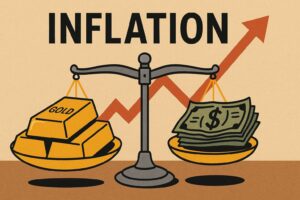
In a world characterized by soaring inflation, market turbulence, and geopolitical instability, gold’s investment benefits are more relevant than ever.
Smart, experienced investors — from institutional portfolio managers to retirement-focused individuals — are increasing gold allocations as part of a broader strategy for wealth preservation and portfolio resilience. This move isn’t mere trend-following; it reflects a calculated response to rising inflation, geopolitical tensions, and market volatility. The advantages of investing in gold — from inflation protection to safe-haven stability — are driving a renewed focus on this time-tested asset.
Inflation Protection: Gold’s Timeless Role
The current wave of inflation, driven by fiscal stimulus, global supply chain disruptions, and rising energy costs, has eroded purchasing power. Gold has historically provided a reliable hedge — during the 1970s, a period marked by double-digit inflation, gold prices surged over 1,300%, outperforming most asset classes.
More recently, during the inflation spike of 2020, gold posted a 25.1% return, reinforcing its resilience when traditional assets faltered. Unlike bonds and equities, gold’s intrinsic value and scarcity allow it to thrive in inflationary environments.
True Diversification for Modern Portfolios
Modern markets have exposed the limitations of traditional diversification, where stocks and bonds often move in tandem during periods of stress. This heightened correlation reduces the effectiveness of conventional portfolio strategies — leaving investors more exposed than they realize. One of the key gold investment benefits is its low correlation with traditional assets, offering true diversification and enhanced portfolio resilience.
Gold’s low correlation with traditional financial assets provides genuine diversification benefits. Allocating 5-15% to gold has been shown to reduce overall portfolio volatility while maintaining competitive returns. Additionally, gold’s role in portfolios extends beyond returns — it provides psychological assurance during times of uncertainty, which can be critical for long-term investment success.
Central Banks Lead the Way
Global central banks, often considered the most informed and strategic investors, are signaling their confidence in gold by expanding reserves. In 2023 alone, they purchased over 1,000 tons of gold, reflecting deepening concerns about currency debasement, financial system fragility, and geopolitical tensions.
These purchases aren’t just tactical — they represent a structural shift in how institutions view gold’s role in the evolving global monetary system. Central bank behavior underscores gold’s rising importance as a stabilizer amid growing economic and political uncertainties.
Crisis Performance When It Matters Most
- 1970s: Gold prices soared over 1,300% during prolonged inflation and economic stagnation.
- 2008 Financial Crisis: Gold rose over 25% from its lows while the S&P 500 plunged nearly 60%. Over the next three years, gold surged approximately 160%, peaking at $1,917.90 per ounce in August 2011.
- 2020 Pandemic: Gold rebounded rapidly amid global lockdowns and market collapses, ending the year up 25%.
Gold’s consistent performance during crises underscores its role as a safe haven asset, independent of corporate earnings, economic growth assumptions, or monetary policy decisions.

The Silver Investment Opportunity Gold Investors Are Missing
Discover why silver may be the smarter investment opportunity now, offering greater growth potential than gold.
Read MoreCurrency Protection and Portfolio Insurance
With the U.S. dollar facing mounting challenges, including rising fiscal deficits and growing global de-dollarization trends, the risk of currency debasement looms large. Gold’s independence from any single nation’s currency makes it the ultimate wealth insurance.
Physical gold ownership, in particular, eliminates counterparty risk and offers liquidity when it matters most. Sophisticated investors understand that direct ownership of gold — whether through allocated accounts or personal vaults — provides privacy, security, and peace of mind.
The mathematical reality of current debt levels suggests that traditional economic growth alone cannot resolve fiscal imbalances, making currency debasement through inflation a likely policy tool.
Strategic Implementation
Building a resilient portfolio with gold requires a systematic allocation approach. Financial experts recommend a 5-15% allocation, complemented by dollar-cost averaging to manage price volatility.
While both physical gold and gold-backed ETFs can play roles, we believe physical gold is superior as it carries no counterparty risk, unlike ETFs which rely on financial intermediaries. Integrating physical gold with digital platforms enhances security, accessibility, and efficiency.
The Time to Act Is Now
Rising inflation, geopolitical instability, and systemic financial risks underscore the urgency of gold allocation. Gold offers not only preservation of purchasing power but also portfolio stability against systemic shocks. Its track record, demand dynamics, and intrinsic value make it a cornerstone of modern portfolios.
For investors seeking resilience and growth in an era of heightened uncertainty, gold investment benefits are undeniable. The question is not whether to include gold, but how much to allocate. To further understand where gold prices might be headed, explore our comprehensive gold price predictions article.
In a landscape of unpredictability, gold’s ancient reliability offers a modern strategy for financial security and long-term success.
Get Gold & Silver Insights Direct to Your Inbox
Join thousands of smart investors who receive expert analysis, market updates, and exclusive deals every week.
- ⏰ Timely alerts on major price moves and important events
- 📢 Market updates from Mike Maloney & Alan Hibbard
- 💡 Strategies to profit from this rare opportunity

Note: This information is provided for educational purposes and should not be considered investment advice. Always consult with qualified financial professionals before making investment decisions.












